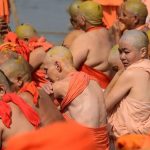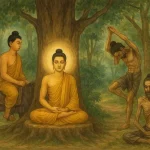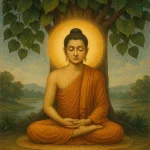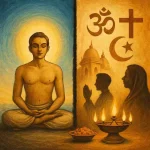India has many saints and philosophers, but the three great spiritual personalities who influenced the Hindu Religion are – Sri Sankaracharya who advocated Advaita Philosophy, Sri Ramaanujaachaarya who advocated Visishtaadvaita philosophy and Sri Madhwacharya who advocated Dvaita Philosophy. The three are together known as the trinity of Indian Philosphy.
Today is the day Madhwacharya, attained Nirvana. Shri Madhwacharya is the Paramaguru of the Gowda Saraswat Brahmin community. Madhwanavami is celebrated on the punya thithi of this guru, which falls on the navami day in the shuklapaksha of the Maghamasa. Though Acharya Sri Madhwa is to be revered and worshipped everyday, two specific days are earmarked in Hindu Lunar calendar for his specific worship. They are, Sri Madhwa Jayanthi falling on Vijayadasami day that is said to be the day on which he was born. The other day is Sri Madhva Navami falling on the 9th day of Lunar month of Magha Masam during the bright fortnight.
All over India especially in the muths owing allegiance to the Tattva Vada of the great saint and philosopher Sri Madhwacharya observe Madhwa Navami. The GSB community under the Kashi Mutt and Gokarn Mutt follow His philosophy. His Punya Thithi is considered very auspicious and celebrated as such. All GSB community temples,especially having Hanuman temple conduct elaborate pujas on the date to ulogise the great saint and all community members participate in them with lot of fervour. Special celebrations are held across the country on the Madhwa Navami day at all the Madhwa related temples and mutts, participated by large gathering of Madhwa followers.

Who is Madhwacharya ?
He was not only a great Saint and Philosopher but he is also strongly believed and considered as the third incarnation of the Wind God (Lord Vayu) known as Mukhya Prana. Other two earlier in this lineage are Lord Hanuman in Treta Yuga and Sri Bheemasena in Dwapara Yuga. It is said that Sri Madhwacharya during his life time had openly identified himself as an incarnation of Lord Vayu which was evidenced by several miracles performed by him right from his childhood days.
Prathamo Hanuman Nama Dwitheeyo Bheema Eva cha
Poornapragna Thrutheeyasthu Bhagavat Kaarya saadhakaha
Sri Madhwacharya known as Vasudeva during his childhood was born around 800 years back in a small village presently known as Pajaka Kshetra about 10 km from the temple town of Udupi near Mangalore in Karnataka State. He was born in a family of Shivalli Brahmins and was the son of Madhyageha Bhatta. Born in 1238 AD Sri Madhwacharya lived for 79 years and left this world on the 9th day of bright fortnight (Navami thithi) in the lunar month Magha Masam that falls two days after the Ratha Sapthami festival. He studied Vedas, Upanishads, Ithihasas, Puranas and various other scriptures and spent his life time in teaching and propagating Dwaita Sidhaantha. He also authored many granthas(books) like Brahmasutra Bhashyam, Tatvodhyotham, Dwadasa sthotram, etc.There were hundreds of shishyas under him.His main pravachana kendra was around Udupi.
A child prodigy, with divine qualities, Sri Madhwacharya was well known for his authority, knowledge and extempore oratory skills, on the subject. During his period he had defeated many of his opponents with his authenticated arguments. Robust in physique and health Sri Madhwacharya was a multifaceted personality also known for his mystic powers. At the age of twelve Sri Madhwacharya left his home to become an ascetic and took up the Sanyasa Deeksha under the guidance of Sri Achyuta Preksha Theertha, his Sanyasa Guru. He was named as Poornaprajnya after attaining Sanyasa Deeksha. Very soon he became the head of the Mutt and came to be known as Ananda Theertha and later as Madhwacharya by which name he became very popular.

His Contribution to Udupi temple
Sri Madhwacharya was born in the Udupi region which is famous for the beautiful Krishna Temple and it is said that it was he who had the idol of Krishna installed here. There is an interesting story as to how he got that Krishna Idol.
Sri Madhwacharya was absorbed in composing Dvaadasha-stotra, his famous twelve-part poem praising Lord Krishna, had gone to the beach to bathe He saw a ship caught in trouble and hearing the cries of the sailors in distress, he waved his cloth in their direction. This calmed the stormy seas, and the ship floated free. He then guided the vessel to safety. In token of gratitude for saving their lives, the captain offered Sri Madhwacharya whatever he wanted from the ship’s cargo. Madhva chose a heavy lump of gopi-chandana clay out of a divine instinct .The Disciples of Sri Madhwacharya had just started back to Udupi with the large lump of clay when, but a short distance from the beach, the lump broke in two, revealing the handsome Deity of Lord BalaKrishna and the deity of Balarama which Sri Madhavacharya installed at Malpe beach, in the Vadabhandeshwara temple. The Krishna deity, he brought to Udupi, and installed in his Matha there. But now the combined effort of thirty of Madhva’s disciples could not budge the Deity. Only when Madhwacharya himself embraced and lifted the Deity as if He were a child did the Deity consent to be moved. In great transcendental ecstasy Madhva carried the Lord the four miles back to Udupi. On the way he completed the remaining seven parts of Dvaadasha-stotra, reciting the verses out loud. Back in Udupi, Madhva bathed the Lord in the lake known as Madhva-sarovara and enshrined Him in the ShriKrishna Matha.
He consecrated it in a temple and personally worshipped it for 20 years. This temple is now one of the most famous Krishna Temples in India. He chose eight young Sanyasis to become the pontiffs of eight mathas he setup around the temple which continue till today.
His Nirvana
It is said that on this day in 1317 AD, Sri Madhwacharya while teaching his disciples the Aitareya Upanishad Bhashya to his disciples at the Sri Anantheshwara Temple , suddenly a heap of flowers were showered on him and he disappeared into the heap of flowers not to be seen later. It is considered as the day he entered the Badarikasrama. It is strongly believed among his followers that Sri Madhwacharya is still present even today in Northern Himalayas (Greater Badari) continuing his spiritual pursuit with Sage Sri Vedavyasa, but beyond ordinary vision.
He is considered to be the third incarnation of Lord Vayu after Hanuman and Bheema and propounded the philosophy of Dwaita or Dualism. Madhwacharya was a social and religious reformer who declared that the path to salvation was open to all and was not limited by birth. His teachings attracted many followers and revived the Bhaghavatha or Bhakthi traditions in Karnataka.
His Philosophy
Shri Madhwacharya was the force behind Dwaita philosophy and he propagated it through his 8 sishyaas chosen at a later stage.He was known as Purnaprajnya and Anandathirtha because of his immense knowledge on vedas, upanishads and various other scriptures and has been able to forcefully argue and convince the experts in theology as well as the general public about his Dwaita philosophy.
The term, Dwaita, is adopted to indicate the dualism or the difference between God and individual souls, emphasised by the Acharya. But this difference between God and soul is one of the doctrines of his philosophy. Sri Vadiraja Swami, the illustrious monk of Madhwacharya’s lineage, had used the term “Tatva Vada” for this philosophy. It is also called ‘Vaishnava Siddhanta’ as distinguished from ‘Mayavada’ or ‘Illusionism’, propagated by the Advaita school of philosophy. As per the teaching of Madhwacharya, God Sri Hari Vishnu is the Supreme Truth and resides in Vaikunta (Heaven) with his consort, Goddess Sri Lakshmi. The world we see is real and the difference is true. Sri Hari is the only independent reality. All living and non- living beings are dependent on Vishnu. Souls and world are dependent on Vishnu and is separate from Vishnu. Bhakti is the only means of attaining Moksha. This is the essence of Dwaita Philsophy.
The basic tenet of Dvaita philosophy is the refutation of the Mayavada of Sri Shankara. Dvaitha emphasizes that the world is real and not just an illusion.
Some of Sri Madhwacharya’s tenets include that:
- The soul is bound to this world through ignorance
- The way for the soul to release itself from this bondage is to seek the grace of Sri Hari
- To reach Sri Hari, one has to practice Bhakthi, there is no other way
- To practice Bhakthi, one needs to meditate
- To meditate, one needs to clear the mind and attain detachment by studying the sacred texts
- Understanding the sacred texts can be possible only through the grace of a Guru
Must read Bhishma Asthtami : Remebereing the noble soul of Mahabharatha
Must read Significance and the story of Rathasaptami









